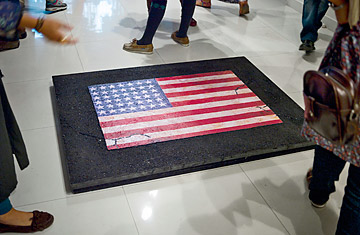
A U.S. flag painted on pavement by the Iranian regime is exhibited at the "America the Beautiful" show.
Tehran's most avant-garde art gallery sits on a quiet, treelined street in the midtown area of the city. Only a tiny white sign with black lettering alerts those looking that they've found their destination. But on Friday nights, the Aaran Gallery is the coolest place in town. Girls in heels, their headscarves slipping back to reveal fantastical upsweeps, hipster boys in skinny jeans and gray-haired intellectuals who look as if they've just stumbled out of the smoke-filled back rooms of a French café mingle and discuss the art that surrounds them. At one opening on a late August afternoon, there was even more to talk about than usual. The show's theme: "America the Beautiful."
Inside the packed space, patrons laugh at an installation showing a home video of Iranian breakdancers doing their best to impress guests at an early 1980s wedding. It's paired with a photograph of Iranians storming the U.S. embassy in 1979 for a piece titled Cultural Invasion, making the point that the U.S. has been more successful at invading Iran's culture — pirated downloads of Desperate Housewives, The Big Bang Theory and Vampire Diaries are all the rage with young Tehranis — than Iran has been in influencing America. Attendees bounce Ping-Pong balls scattered around the gallery, each imprinted with blue and red stars and the names of famous Americans, ranging from Marilyn Monroe to Barack Obama. And they step carefully around a U.S. flag painted on a piece of sidewalk that has been replanted on the gallery floor — one of thousands painted all over Iran by the government and meant to be stomped on as a symbol of scorn for the U.S. "America is bigger than the geography of the country. It's an idea," says the exhibition's 28-year-old curator, Mahoor Toosi. Most of the show's young artists have never visited the U.S., and yet it has left an indelible impression on their lives. "The question of what America really is wasn't my concern. Each and every person has a different view of America. I wanted to capture their Persian views."
As Iran continues to defy the West over its nuclear program and suffers economically under a welter of sanctions, even toying with images of America — let alone the Islamic Republic's depiction of a country still referred to by some as the Great Satan — might seem politically risky. Hundreds of political activists, journalists and critics of the regime have been arrested, imprisoned and killed in the hard-line crackdown of recent years. The government has also stifled Iran's music and film industries. Threatened from within and without, the regime demands loyalty from all. Dissent has become distinctly dangerous.
That makes the Iranian contemporary-art scene all the more remarkable. Tehran has so far allowed it to flourish not only in the form of galleries like Aaran but also in prolific shows and sales abroad. Why? It's partly thanks to a loophole in U.S. and European sanctions that allows those countries to import certain fine art from Iran. The regime's need for hard foreign currency, especially since the Iranian rial has lost more than 75% of its value in the past year, has helped protect the market, as has demand from investors seeking safe havens from hyperinflation for their savings. Most of the art is far too subversive to be shown in Iran and is sold to buyers overseas. So in a twist, as the threat of war with Israel looms and Tehran cracks down on protesters weary of Western sanctions that are making it harder for ordinary people to get by, the government is quietly tolerating dissident imagery to generate the revenue it needs to help stabilize an economy on the brink.
The contemporary-art movement in Iran got a boost under the last Shah, whose wife Farah was a collector of Western and Iranian art. The bulk of her collection today resides in the Tehran Museum of Contemporary Art, the opening and closing of which depends on the mood of the regime. Some days the public is barred from seeing what certain clerics may view as decadent or indecent Western images.
After the 1979 revolution, the contemporary-art movement stalled, only to be revived by the relatively liberal cleric Mohammed Khatami, who became President in 1997. He set aside part of the national budget — albeit a tiny fraction, less than one-tenth of 1% — to support art. His government funneled those funds to galleries, studios and contemporary artists, helping renovate a wonderful space for young artists called the Arts House, a former army barracks. In recent years the conservative government of President Mahmoud Ahmadinejad has steered that money to calligraphy and more traditional Persian arts. But the contemporary-art movement has thrived long past Khatami's fall, even as the regime grew more oppressive — or perhaps because of it. "A lot of [Iranian contemporary art] is directly related to politics. A lot of it is happening because of the pressure," says Nazila Noebashari, Aaran's owner. "It's like a cooking pot in so many ways." The more pressure the government puts on its people to conform, the more they express their distinctiveness through art.
